Shorter-term inflation expectations largely unchanged; longer-term inflation expectations unchanged at 1.7%…
https://www.ecb.europa.eu//press/pr/date/2021/html/ecb.pr210122_1~6e44470873.en.html
Shorter-term inflation expectations largely unchanged; longer-term inflation expectations unchanged at 1.7%…
https://www.ecb.europa.eu//press/pr/date/2021/html/ecb.pr210122_1~6e44470873.en.html
The following competent authorities comply or intend to comply with ESMA’s Guidelines on liquidity stress testing in UCITS and AIFs…
https://www.esma.europa.eu/file/111268/download?token=-0Wju7JW

Artificial Intelligence, Machine Learning, IoT and Digital Platforms are some of the new technological paradigms that are significantly changing insurance market dynamics, in terms of customers’ needs, expectations and ways of connecting with Insurance Companies.
More than ever before, insurance Companies have to manage an increasing demand of innovation by:

The current pandemic scenario and the need of “social distancing” is going to dramatically change both customer behaviors and the way to approach him. Customers are increasingly looking for digital ways of interaction (e.g. on-line policy renewal, digital payments, etc.) and, in the meantime, get the “human touch” by relying on the distribution network as a distinctive element of quality of service.
Rethinking the Customer Journey along the overall claim lifecycle in a digital perspective has a crucial role since the customer satisfaction is one of the most relevant factor of the renewal process (e.g. settlement speed and amount of reimbursementsupporting customer retention).
An E2E Digital Claims Journey can be made up of:
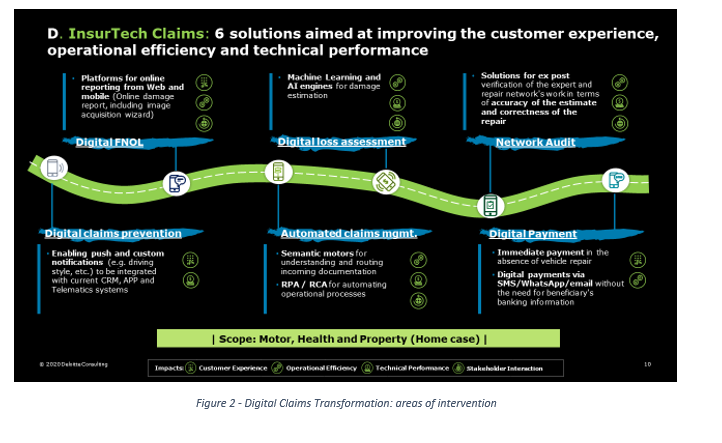
The benefits of digital solutions adoption in claim management can be summarized as follows:
The above mentioned benefits become more and more relevant also in terms of technical performances consolidation, especially in a market context characterized by negative Motor premium collection and strong pressures on pricing.
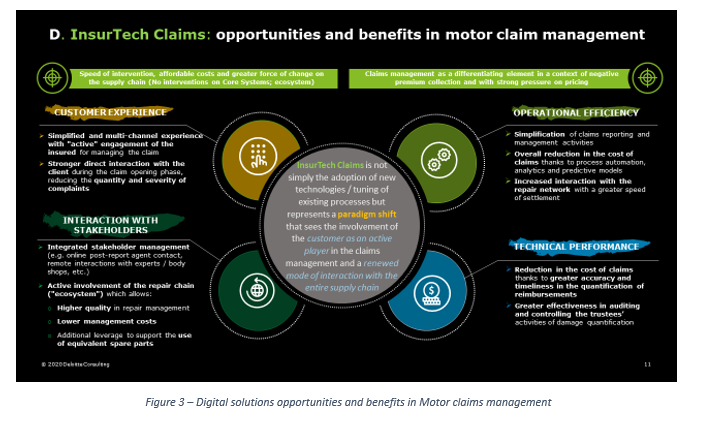
Companies’ capability to innovate claims management processes will be crucial to address customer needs and choices and it will become the real competitive advantage in a context already characterized by customer loyalty decreasing trend.
An innovative approach in claims management is not only referred to the identification and introduction of new technologies that could become quickly obsolescent, neither to the adoption of traditional process leveraging digital technologies but it is a matter of continuous and constant aspiration to reach the maximum efficiency.
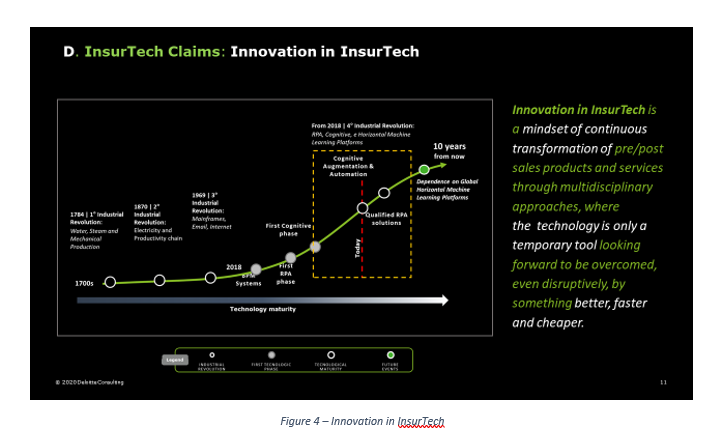
The adoption of a claims management solution based on new digital paradigms must provide an organic and structured path that gives access to available technologies, changing them over time, safeguarding the specificities and distinctiveness of the Insurance Companies. It is highly recommended to adopt an operational approach that includes:
Insurance Companies that will be able to combine new technologies with their own peculiarities in terms of product and service model will achieve an important competitive advantage to increase customer retention, attract new customers and, at the same time, optimize their operations and technical performance.
Romano Sacchi – Partner Deloitte Consulting
Maria Cristina De Anna – Director Deloitte Consulting
Alessandro Greco – Senior Manager Deloitte Consulting
Davide Adduci – Manager Deloitte Consulting

L’iniziativa di Finriskalert.it “Il termometro dei mercati finanziari” vuole presentare un indicatore settimanale sul grado di turbolenza/tensione dei mercati finanziari, con particolare attenzione all’Italia.
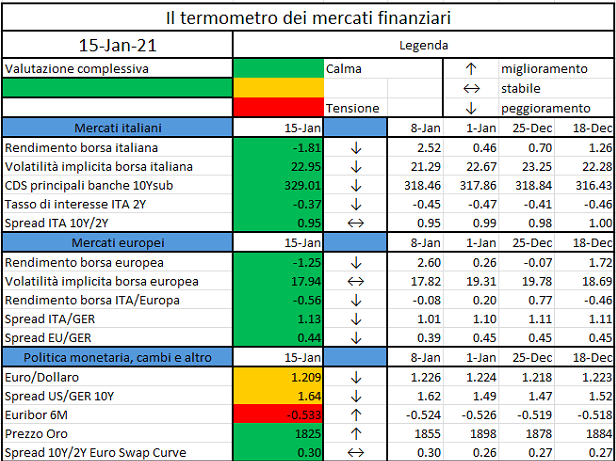
Significato degli indicatori
I colori sono assegnati in un’ottica VaR: se il valore riportato è superiore (inferiore) al quantile al 15%, il colore utilizzato è l’arancione. Se il valore riportato è superiore (inferiore) al quantile al 5% il colore utilizzato è il rosso. La banda (verso l’alto o verso il basso) viene selezionata, a seconda dell’indicatore, nella direzione dell’instabilità del mercato. I quantili vengono ricostruiti prendendo la serie storica di un anno di osservazioni: ad esempio, un valore in una casella rossa significa che appartiene al 5% dei valori meno positivi riscontrati nell’ultimo anno. Per le prime tre voci della sezione “Politica Monetaria”, le bande per definire il colore sono simmetriche (valori in positivo e in negativo). I dati riportati provengono dal database Thomson Reuters. Infine, la tendenza mostra la dinamica in atto e viene rappresentata dalle frecce: ↑,↓, ↔ indicano rispettivamente miglioramento, peggioramento, stabilità rispetto alla rilevazione precedente.
Disclaimer: Le informazioni contenute in questa pagina sono esclusivamente a scopo informativo e per uso personale. Le informazioni possono essere modificate da finriskalert.it in qualsiasi momento e senza preavviso. Finriskalert.it non può fornire alcuna garanzia in merito all’affidabilità, completezza, esattezza ed attualità dei dati riportati e, pertanto, non assume alcuna responsabilità per qualsiasi danno legato all’uso, proprio o improprio delle informazioni contenute in questa pagina. I contenuti presenti in questa pagina non devono in alcun modo essere intesi come consigli finanziari, economici, giuridici, fiscali o di altra natura e nessuna decisione d’investimento o qualsiasi altra decisione deve essere presa unicamente sulla base di questi dati
U.S. banking powerhouse Goldman Sachs has issued a request for information (RFI) to explore digital asset custody, according to a source inside the bank…
https://www.coindesk.com/goldman-sachs-to-enter-crypto-market-soon-with-custody-play-source
Increased lending by non-banks in the last three decades has significantly changed the US financial intermediation system. Additionally, non-banks may affect financial stability, both directly and through their linkages with the banking system…
https://www.bis.org/publ/work919.htm
The dynamic properties of sovereign bonds in emerging market economies and their associated risk premiums. We focus on the interaction between credit and currency risks, ie the Twin Ds, reflected in local currency bonds issued by sovereigns in Asia-Pacific…
https://www.bis.org/publ/work918.htm
The European Central Bank (ECB) concluded its public consultation on the digital euro yesterday and will now analyse in detail the large number of responses. 8,221 citizens, firm…
https://www.ecb.europa.eu//press/pr/date/2021/html/ecb.pr210113~ec9929f446.en.html

Abstract
In this short note we briefly review the state of the art of the ongoing transition from interbank rates (IBORs) to alternative risk free rates, with a focus on LIBOR and EUR benchmark rates. This note is a reduced version of a position paper published by AIFIRM in December 2019 [1], reporting more details regarding the impacts of the transition on Bank’s internal processes, updated to December 2020.
The Inter-Bank Offered Rates (IBORs) have been widely used by the market players as benchmarks for an enormous number of market transactions and a broad range of financial products since their invention by M. Zombanakis in 1969 [2] and their successive standardization by the British Bankers’ Association in 1986 [3].
Currently, IBORs are the predominant interest rate benchmark for USD, GBP, CHF, EUR and JPY derivatives contracts [4]. EURIBOR is the most widely used interest rate benchmark for EUR contracts [5]. They are calculated through contributions from panel banks, and they reflect the offered rates for interbank unsecured wholesale deposits. IBORs indexed OTC derivatives and ETDs represent approximately 80% of IBOR-linked contracts by outstanding notional value, and thus derivatives represent the focus for global transition and reform initiatives. Going forward, this focus will include other products, such as securities, loans and mortgages.
After the LIBOR manipulation scandals [6][15], in 2013 IOSCO issued a set of principles that administrators of financial benchmarks should comply with, stating that interest rates must be reliable, robust and reflect real transactions [7].
By that time, the G20 had also mandated the Financial Stability Board (FSB) with conducting a global review of the main benchmarks and plans for their reform, in order to ensure that these were coherent and coordinated to the extent possible. In its 2014 report “Reforming major interest rate benchmarks” [8] the FSB recommended:
In the euro area, the reform efforts were accelerated by the adoption of the EU Benchmarks Regulation (BMR) on 8 June 2016 [9], which codifies the IOSCO Principles into EU law and defines critical benchmarks that need a robust framework: EONIA, EURIBOR, LIBOR, STIBOR, WIBOR. Among other requirements, since 1January 2018 BMR requires to include fallback clauses in specific type of contracts and permit the usage of critical benchmarks not compliant to the BMR until 31 December 2021.
Following these new requirements, in particular, EONIA, EURIBOR and LIBOR, were the subject of a deep reform, accelerated in the case of LIBOR from the statement of the Financial Conduct Authority (FCA) that confirmed it will no longer compel banks to submit LIBOR post December 2021.
In order to lead the market through the reform and with the will to be the link between market participants and regulators, each jurisdiction established a Working Group (WG) to define the Alternative Risk Free Rate (Alt-RFR) for the different currencies with which IBORs are contributed.
Starting from the IOSCO principles and the following Authorities’ guidelines, the Alt-RFRs are:
Table 1 below reports the main features of the reference risk free rates identified by the WGs: they will side next to the IBORs and eventually substitute them.
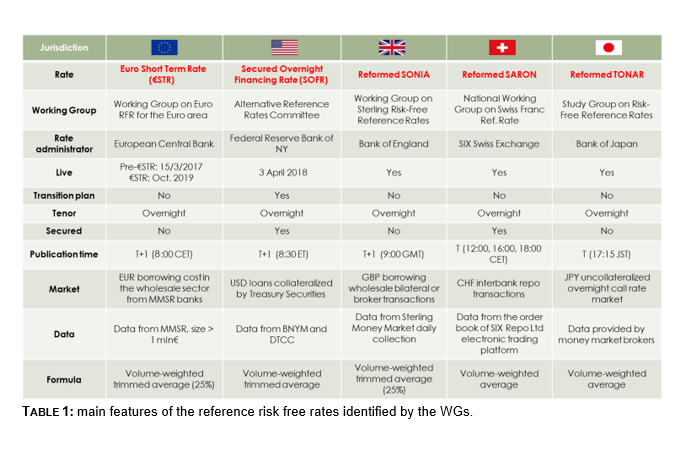
In February 2018, the European Central Bank (ECB), the Financial Services and Markets Authority
(FSMA), the European Securities and Markets Authority (ESMA) and the European Commission
established the working group on euro risk-free rates (the ECB WG, [10]). The working group was tasked with (i) identifying risk-free rates which could serve as the basis for an alternative to the current benchmarks used in a variety of financial instruments and contracts in the euro area, (ii) identifying best practices for contractual robustness, and (ii) developing adoption plans – and, if necessary – a transition plan for legacy contracts which reference existing benchmarks.
The ECB WG works to provide guidelines and recommendations to market participants, in order to facilitate a smooth transition: its recommendations apply to different areas of impact (legal, accounting, risk management, etc.). In particular, the Working Group recommended €STR as euro risk-free rate on 13th September 2018 [11] [12]. Some of the key properties of €STR are:
Since 1 October 2019 €STR is published and EONIA is computed as EONIA = €STR + 8.5 bps, a one-off spread provided by the ECB, calculated as the arithmetic average of the daily spread between EONIA and pre-€STR (data from 17/04/2018 until 16/04/2019), after removing the 15% of observations from the top and the bottom of the sorted series.
Also the timing changed: while EONIA was published at 19.00 CET on each business day (T), €STR is published at 8:00 CET on the next business day (T+1). In case of errors in the €STR calculation that affect the rate value by more than 2 bps, €STR is revised and re-published on the same day at 09:00 CET. As a consequence of the recalibrated methodology, also EONIA is published on the next business day (T+1) at 9:15 CET.
EONIA will be published until 3 January 2022, when it is discontinued. Before its discontinuation, market participants have to perform a series of activities to be ready. The ECB WG issued a lot of recommendations to address a smooth transition and the milestones are:
The transition from EONIA to €STR has a number of consequences on the valuation of derivatives, as outlined e.g. in [13].
EURIBOR is the commonly used term rate for euro denominated financial contracts. EURIBOR reflects the rate at which wholesale funds in euro can be obtained by credit institutions in EU and EFTA countries in the unsecured money market, and seeks to measure banks’ costs of borrowing in unsecured money markets [5].
In 2016, EURIBOR was declared a critical benchmark by the European Commission, so its administrator, the Euro Money Markets Institute (EMMI), has conducted in-depth reforms in recent years in order to meet the BMR requirements, by strengthening its governance framework and developing a hybrid methodology in order to ground the calculation of EURIBOR, to the extent possible, in euro money market transactions.
In July 2019, the supervisor of EURIBOR, the FSMA, granted authorisation to EMMI for hybrid-EURIBOR under the BMR. This authorisation provides confirmation that EMMI and the EURIBOR hybrid methodology meet the requirements laid down in the BMR and that EURIBOR may continue to be used in new and legacy contracts.
Starting from the end of 2019 all panel banks contribute their data following the “hybrid” determination methodology developed by EMMI, based on a 3 levels hierarchy, as illustrated in Figure 1 below.
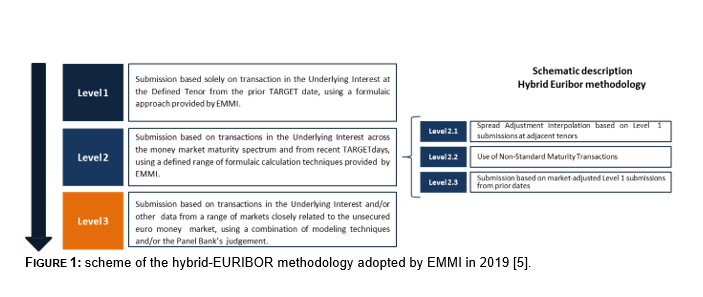
The ECB WG recommended to use the €STR term structure as a fallback to EURIBOR [14]. On 23 November 2020 the ECB WG issued two consultantions on fallback trigger event and €STR-based fallback whose results will be shared during the ECB WG meeting in February 2021 [15]. Starting from the industry’s feedbacks, the ECB WG will issue recommendations on fallback rates to be applied to different products. It is worth to be highlighted that €STR will be the EURIBOR fallback rate, but the calculation methodology will depend on the products to be applied.
The Financial Stability Board and Financial Stability Oversight Council have both publicly recognized that the decline in wholesale unsecured term money market funding by banks poses structural risks for unsecured benchmarks, including LIBOR. Although significant progress has been made by the LIBOR Administrator (ICE Benchmark Administration – IBA) in strengthening the governance and processes underlying LIBOR, the scarcity of underlying transactions poses a continuing risk of a permanent cessation of its production after the end of 2021.
Andrew Bailey, then the Chief Executive of the United Kingdom’s Financial Conduct Authority (FCA)
highlighted this end-2021 timeline in a speech in 2017 [16] and the FCA recently reemphasized [17] that the central assumption that firms cannot rely on LIBOR being published after the end of 2021 has not changed and that this should remain the target date for all firms.
On December 4, 2020, IBA published its consultation, with deadline January 25, 2021, on its intention to cease the publication of the LIBORs (CHF, GBP, JPY and EUR) on December 31, 2021, considering some postponements only for USD LIBOR until June 30, 2023 [4].
Different WGs are providing recommendations to lead a smooth transition from USD, GBP, CHF, JPY and EUR LIBOR to, respectivey, SOFR, SONIA, SARON, TONA and €STR: with 13 months left until LIBOR could become unusable, it is important that market participants accelerate their transition efforts, having in mind that:
Considering the cleared USD OTC derivatives, the CCPs switched the PAI and discounting regime in October 2020 from Fed Fund Rate to SOFR through a complex mechanism. Since there is no fix spread between EFFR and SOFR, the switch resulted in cash compensation, to manage the valuation change, and swap compensation, to manage risk profile change.
The first next milestone that USD market participants have to reach before the USD Libor discontinuation is the PAI and discounting regime switch for derivatives under bilateral CSAs.
The second next milestone for the LIBOR WGs is to lead the market participants in the construction of a term rate structure or address the impacts that the only use of overnight rate compounding could cause (e.g. some derivatives cannot be priced with compounded rates).
In 2016, the Official Sector Steering Group (OSSG) formally launched a major initiative to improve contract robustness and address the risks of widely-used interest rate benchmarks being discontinued. The OSSG invited ISDA to lead this work as it pertained to derivative contracts – the largest source of activity for the IBORs.
ISDA [18] conducts its work through different WGs: ISDA Americas and Europe Benchmark WG, ISDA APAC Benchmark WG, ISDA JPY Benchmark WG, ISDA EU Benchmark Regulation Advocacy Group and the ISDA IBOR Fallback Implementation Subgroup.
To address the risk that one or more IBORs are discontinued while market participants continue to have exposure to that rate, counterparties are encouraged to agree to contractual fallback provisions that would provide for adjusted versions of the RFRs as replacement rates.
ISDA developed fallbacks that would apply upon the permanent discontinuation of certain IBORs and upon a ‘non-representative’ determination for LIBOR. ISDA will amend the 2006 ISDA Definitions by publishing a ‘Supplement’ to the 2006 ISDA Definitions on January 25, 2021: transactions incorporating it, that are entered into on or after the date of the Supplementwill include the amended floating rate option (i.e., the floating rate option with the fallback). Transactions entered into prior to the date of the Supplement (so called “legacy derivative contracts”) will continue to be based on the 2006 ISDA Definitions as they existed before they were amended pursuant to the Supplement, and therefore will not include the amended floating rate option with the fallback.
ISDA has published a protocol [19] to facilitate multilateral amendments to include the amended floating rate options, and therefore the fallbacks, in legacy derivative contracts. By adhering to the protocol, market participants would agree that their legacy derivative contracts with other adherents will include the amended floating rate option for the relevant IBOR and will therefore include the fallback. The protocol is completely voluntary and will amend contracts only between two adhering parties (i.e., it will not amend contracts between an adhering party and a non-adhering party or between two non-adhering parties). The fallbacks included in legacy derivative contracts by adherence to the protocol will be exactly the same as the fallbacks included in new transactions that incorporate the 2006 ISDA Definitions and that are entered into on or after January 25, 2021.

L’iniziativa di Finriskalert.it “Il termometro dei mercati finanziari” vuole presentare un indicatore settimanale sul grado di turbolenza/tensione dei mercati finanziari, con particolare attenzione all’Italia.
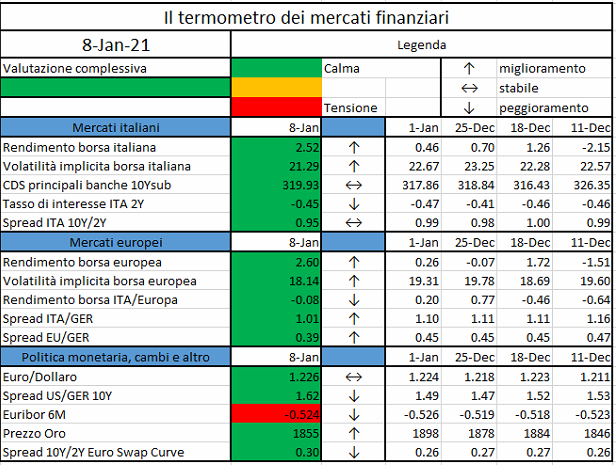
Significato degli indicatori
I colori sono assegnati in un’ottica VaR: se il valore riportato è superiore (inferiore) al quantile al 15%, il colore utilizzato è l’arancione. Se il valore riportato è superiore (inferiore) al quantile al 5% il colore utilizzato è il rosso. La banda (verso l’alto o verso il basso) viene selezionata, a seconda dell’indicatore, nella direzione dell’instabilità del mercato. I quantili vengono ricostruiti prendendo la serie storica di un anno di osservazioni: ad esempio, un valore in una casella rossa significa che appartiene al 5% dei valori meno positivi riscontrati nell’ultimo anno. Per le prime tre voci della sezione “Politica Monetaria”, le bande per definire il colore sono simmetriche (valori in positivo e in negativo). I dati riportati provengono dal database Thomson Reuters. Infine, la tendenza mostra la dinamica in atto e viene rappresentata dalle frecce: ↑,↓, ↔ indicano rispettivamente miglioramento, peggioramento, stabilità rispetto alla rilevazione precedente.
Disclaimer: Le informazioni contenute in questa pagina sono esclusivamente a scopo informativo e per uso personale. Le informazioni possono essere modificate da finriskalert.it in qualsiasi momento e senza preavviso. Finriskalert.it non può fornire alcuna garanzia in merito all’affidabilità, completezza, esattezza ed attualità dei dati riportati e, pertanto, non assume alcuna responsabilità per qualsiasi danno legato all’uso, proprio o improprio delle informazioni contenute in questa pagina. I contenuti presenti in questa pagina non devono in alcun modo essere intesi come consigli finanziari, economici, giuridici, fiscali o di altra natura e nessuna decisione d’investimento o qualsiasi altra decisione deve essere presa unicamente sulla base di questi dati